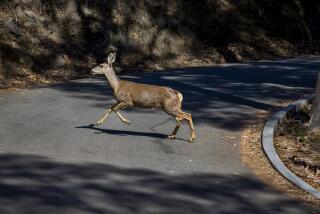Widespread Taming of Pigs Sheds Light on Human Migration
Mean-tempered, big-tusked wild boars were transformed thousands of years ago into floppy-eared domestic pigs not once or twice but repeatedly in many parts of the world as humans abandoned foraging and hunting for a settled farming life.
In a report published today in the journal Science, scientists used DNA from wild boars and pigs to conclude that pig domestication occurred in at least seven places through the millennia.
“The question is no longer where pigs were domesticated but where pigs were not domesticated,” said Greger Larson, a doctorate student at the University of Oxford and the paper’s first author.
The pig work provides a new tool for tracking movements of prehistoric humans, the authors said. By assessing the genes of local domestic pigs, researchers could learn where the animals’ wild boar ancestors hailed from -- and uncover ancient trade routes and human migration paths.
The pig DNA data have suggested that a theory about Pacific Islanders originally coming from Taiwan is incorrect. The data show that pigs in Hawaii do not match wild boars from Taiwan, the authors said.
The widespread origin of domestic pigs about 9,000 years ago is unusual in the history of animal domestication. Sheep, cows, horses and goats were thought to have been domesticated just a handful of times during human farming history, mostly in the Fertile Crescent of the Near East.
Charles Darwin, among others, proposed that pigs were domesticated just twice -- in Asia and the Near East -- then transported by Neolithic migrants who carried their farming culture with them.
Larson and his coauthors in Sweden, England and New Zealand extracted DNA from bones of wild boars and domestic pigs and scrutinized previously gathered genetic samples of pigs.
Comparing the structure of a tiny segment of DNA from a total of 362 wild boars and 324 domestic pigs from 40 countries, they found that wild boars had distinct genetic sequences depending on where they originated.
The scientists then matched the DNA of the pigs to the boars. They concluded that pigs were domesticated in central Italy, India, Burma-Thailand and western Indonesia-New Guinea, in addition to previously identified locations in the Near East and China.
The pig data add to emerging theories that the domestication of animals occurred multiple times in different places, said Jared Diamond, a professor of geography and physiology at UCLA and a scholar of human civilizations.
“There’s now evidence not only for pigs but that cows were domesticated at least three times -- around the Fertile Crescent ... in India ... and North Africa,” Diamond said.
The first steps in pig domestication were likely initiated by the boar. Boars that were less cautious and more friendly would venture close to villages to root through trash.
These boars tended to be ones that maintained a more juvenile behavior compared to the aggressive and skittish demeanor of normal wild adults.
Boars that exhibited this juvenile behavior got more food and were able to breed more. Over time, juvenile traits -- not only tameness but also shorter snouts, smaller tusks and squealing -- became bred into early domesticated pigs.
Only later would pigs have been deliberately bred by human beings for traits such as extreme size and hairlessness, said Keith Dobney, a coauthor of the study and an archeologist at Britain’s University of Durham.






